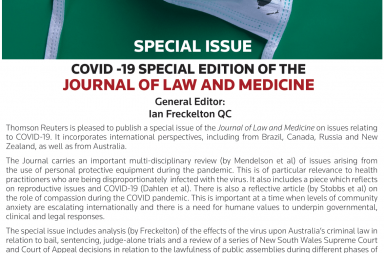*Please note that the links to the content in this Part will direct you to Westlaw AU. If you are still using Legal Online, the links can be found in the LOLA PDF at the bottom of this post.
The latest issue of The Tort Law Review (Volume 20 Part 3) contains the following material:
Articles
When worlds collide: Transatlantic efforts to curb libel tourism and their implications for Australia – Michael Gillooly
“Libel tourism†is a pejorative term applied to the practice of commencing defamation proceedings in a jurisdiction with only tenuous links to the parties or the publications in order to obtain a forensic advantage. The practice has proved so controversial that legislation to curb it has been enacted or proposed on both sides of the Atlantic. The purpose of this article is threefold: first, to outline the practice of libel tourism; secondly, to trace the development of the anti-libel tourism legislation adopted in the United States and proposed in the United Kingdom; and thirdly, to consider the implications of the practice and the legislation for Australia. It will be seen that libel tourism provides a fascinating and instructive illustration of the interplay between the law of defamation and the principles of private international law in our modern globalised world.
To purchase this article, complete the Individual Article Sale order form and email it to [email protected].
Wilkinson v Downton: Pathways to the future? – Peter Handford
In Wilkinson v Downton [1897] 2 QB 57, Wright J held that a tort action was available where the defendant wilfully did an act calculated to cause physical harm, and physical harm resulted. Though some judges have recently said that this cause of action has now been overtaken by negligence, it has also been suggested that the common law could move forward from this case and develop a tort of intentionally causing distress without the need to show bodily or psychiatric illness. The United States tort of intentional infliction of emotional distress, which grew out of a cause of action very like Wilkinson v Downton, provides an example. This article suggests there is another potential source of inspiration, namely the development of cruelty as a ground for matrimonial relief. The article concludes by examining recent Wilkinson v Downton case law which indicates that the law may be taking some steps in the suggested direction.
To purchase this article, complete the Individual Article Sale order form and email it to [email protected].
A consideration of “scope of liability†within the Restatements – Nicola Bodor
“Scope of liability†is a relatively new addition to the determination of cause in negligence. Indeed, in the most recent Restatement of the Law, Third, Torts: Liability for Physical and Emotional Harm, the American Law Institute has, for the first time, actually used the term in a separate chapter on factual cause. Although the concept of limiting factual cause in some way has always been present in causative analysis, it is only recently that such an idea has been given its own voice. What exactly does “scope of liability†mean, however? What is the background to its development in the United States? What policy concerns is it masking? This article traces the development of limiting “but for†cause through to the most recent Restatement on physical and emotional harm and discusses what might actually be meant by the idea of scope of liability.
To purchase this article, complete the Individual Article Sale order form and email it to [email protected].
Simplifying Canadian negligence actions against public authorities – or maybe not – Bruce Feldthusen
Many lawyers and judges believe that despite the unique statutory origins of public authorities, they should be held liable in negligence exactly like any private party. This article suggests that public authority negligence law could be remarkably simplified without any adverse consequences by adopting precisely such a test for recognising a duty of care – recognising a prima facie duty of care whenever a duty would lie in private party negligence in the same or meaningfully analogous situations. The more challenging case is the one in which the plaintiff seeks to establish a unique duty of care owed by a public authority on grounds that would not support a cause of action against a private defendant. The article suggests that it is time to acknowledge that such cases do exist, and time to justify them, if they can be justified, as unique efforts to expand judicial control of governments and public authorities. Proximity as we know it provides no such justification.
To purchase this article, complete the Individual Article Sale order form and email it to [email protected].
For the pdf version of the table of contents, click here: LOLA – Tort L Rev Vol 20 Pt 3 Contents or here: WAU – Tort L Rev Vol 20 Pt 3 Contents.


